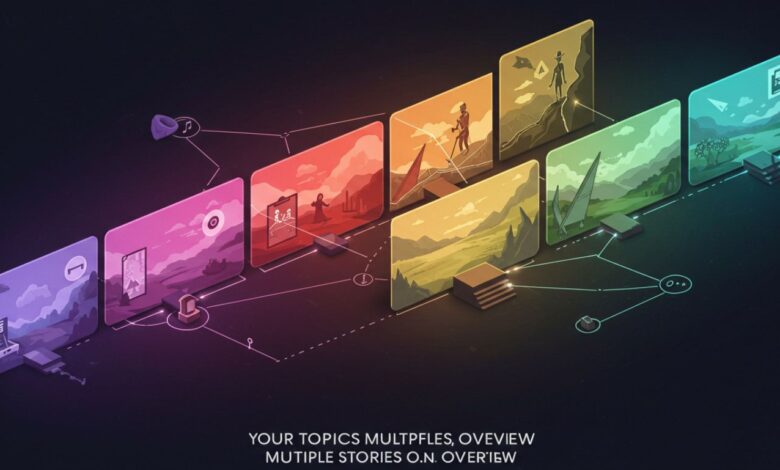
The phrase Your Topics Multiple Stories represents the way ideas, experiences, and events unfold across different viewpoints. In today’s digital age, no story exists in isolation—there are always multiple perspectives, interpretations, and angles. This concept is especially relevant in news, culture, business, and personal expression.
From journalism to social media, the idea of multiple stories emerging from a single topic demonstrates how interconnected and complex human communication has become.
Why Multiple Stories Matter
Every event or topic can generate more than one version of the truth. Your Topics Multiple Stories reflects:
-
Diverse human perspectives
-
Cultural interpretations
-
Conflicting opinions
-
Broader social implications
By recognizing these narratives, we gain a fuller understanding of issues that shape our world.
The Role of Media in Your Topics Multiple Stories
Modern media thrives on multiple viewpoints. Traditional news often gave a single, authoritative voice. Today, digital platforms encourage multiple parallel stories:
-
News outlets report the same event with different emphases.
-
Blogs add personal commentary.
-
Social media amplifies firsthand accounts.
This dynamic ecosystem shows how “truth” is now multi-layered and influenced by context.
Your Topics Multiple Stories in Social Media
Social platforms have become the largest drivers of multiple stories. A single trending topic can create thousands of narratives:
-
Hashtags group stories together.
-
Viral posts present individual voices.
-
Influencers interpret events for their followers.
This democratization of storytelling empowers individuals but also complicates the quest for accuracy.
Personal Narratives and Multiple Stories
Not all stories are global. Many are deeply personal. Your Topics Multiple Stories can emerge in families, communities, or workplaces.
For example:
-
A single family event might be remembered differently by each member.
-
A workplace change can be interpreted uniquely by employees, managers, and customers.
Personal perspectives ensure that every story is layered and multifaceted.
Your Topics Multiple Stories in Culture
Culture shapes the way stories are told. An event viewed through one cultural lens may be celebrated, while another culture may see it critically. This highlights how:
-
Values influence interpretation.
-
Traditions shape storytelling.
-
History provides context.
Recognizing cultural diversity helps us appreciate the richness of multiple stories.
Business and Branding Stories
In business, Your Topics Multiple Stories appear in branding and marketing. A product launch can spark:
-
The official corporate narrative.
-
Consumer feedback stories.
-
Competitor responses.
Brands must manage these narratives carefully to maintain trust and reputation.
Political Narratives and Multiple Stories
Politics thrives on competing stories. A single policy may be seen as progress by some and regression by others. Multiple narratives emerge from:
-
Party ideologies
-
Media spin
-
Public reactions
Understanding political issues requires recognizing these parallel stories.
Education and Storytelling
In education, the concept of multiple stories teaches critical thinking. Students learn to:
-
Analyze sources.
-
Compare perspectives.
-
Recognize bias.
This skill is essential in navigating the complexity of modern information.
Technology’s Role in Shaping Multiple Stories
Technology accelerates the spread of Your Topics Multiple Stories. With smartphones, anyone can record and share experiences instantly. Algorithms then amplify certain versions of stories based on engagement, creating echo chambers.
The result: stories multiply faster than ever before, sometimes distorting truth.
Journalism and Objectivity
Traditional journalism often aimed for objectivity. But in reality, Your Topics Multiple Stories show that complete neutrality is nearly impossible. Instead, journalism now embraces:
-
Transparency of sources
-
Clear distinction between fact and opinion
-
Inclusion of multiple voices
This approach strengthens trust while acknowledging complexity.
Globalization and Multiple Stories
Globalization has connected diverse societies, meaning stories travel across borders. A local event can quickly become global, generating interpretations in different languages and cultural contexts.
Your Topics Multiple Stories remind us that the world is interconnected through narrative exchange.
Conflicts and Contradictions
With multiple stories come contradictions. One person’s truth can be another’s misinformation. Your Topics Multiple Stories highlight the challenge of balancing:
-
Fact vs. opinion
-
Evidence vs. speculation
-
Objectivity vs. bias
Navigating these contradictions requires critical thinking and discernment.
The Psychology of Storytelling
Why do people create multiple stories from the same topic? Psychology plays a role. Memory, emotion, and personal identity influence storytelling. Two individuals at the same event may recall it differently because of:
-
Emotional impact
-
Prior beliefs
-
Social influence
Your Topics Multiple Stories are natural outcomes of human perception.
Storytelling in Business Leadership
Leaders use storytelling to inspire and guide teams. Yet, employees may interpret messages differently. Multiple stories emerge, affecting morale and company culture.
Strong leadership acknowledges these narratives and works to align them with shared goals.
Creative Expression Through Multiple Stories
Art, literature, and film thrive on multiple stories. Writers often explore the same theme through various characters, while films present alternate endings.
This creativity reflects reality: life itself is not a single story, but a web of overlapping experiences.
Challenges of Multiple Stories in Society
While diversity of perspectives enriches us, challenges arise:
-
Misinformation spreads quickly.
-
Polarization grows when groups cling to their versions.
-
Confusion increases without credible sources.
Balancing freedom of expression with responsibility is critical.
The Future of Your Topics Multiple Stories
Looking ahead, storytelling will become even more interactive. Virtual reality, AI, and digital platforms will allow individuals to create and share richer, multi-perspective stories.
Your Topics Multiple Stories will continue to shape identity, politics, and culture. The question is whether societies can embrace diversity without fragmenting truth.
FAQs
What does Your Topics Multiple Stories mean?
It refers to how one topic can produce many narratives depending on perspective, culture, or context.
Why are multiple stories important?
They enrich understanding by presenting different angles of the same event.
Do multiple stories cause confusion?
Yes, but they also encourage critical thinking and deeper analysis.
How does technology affect storytelling?
It multiplies narratives by enabling instant sharing and algorithmic amplification.
Can multiple stories exist without conflict?
Yes, when viewed as complementary rather than contradictory.
Where are multiple stories most visible today?
In media, politics, social platforms, and cultural discourse.
Conclusion
The concept of Your Topics Multiple Stories reflects our interconnected, diverse world. From media to culture, from politics to personal life, every subject generates multiple narratives. This reality demands open-mindedness, critical thinking, and respect for differing perspectives.
Far from being a challenge alone, multiple stories are an opportunity. They allow us to see beyond singular truths and appreciate the rich, layered reality of human experience.




